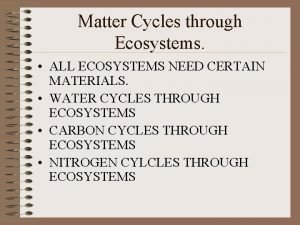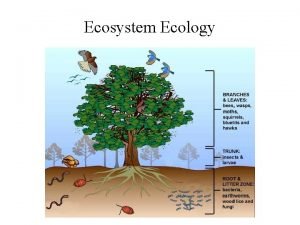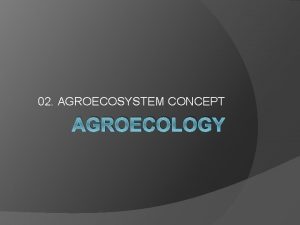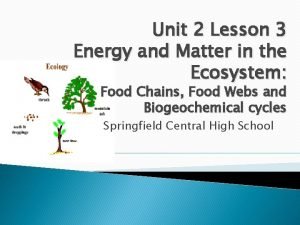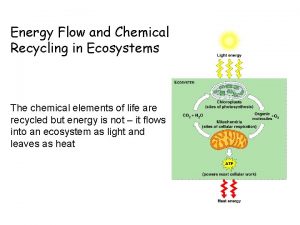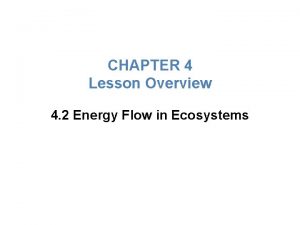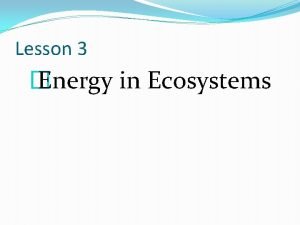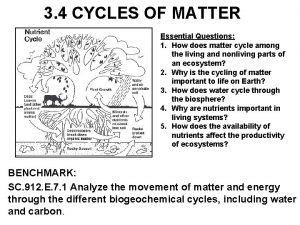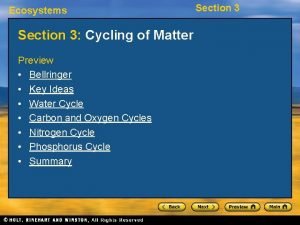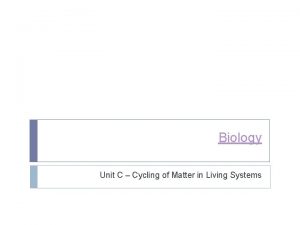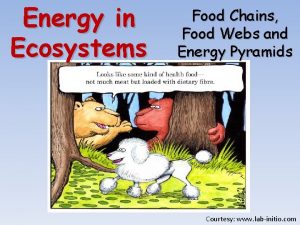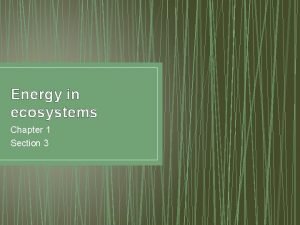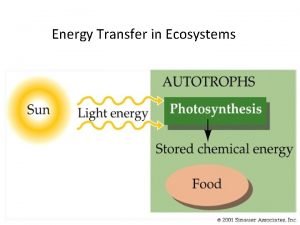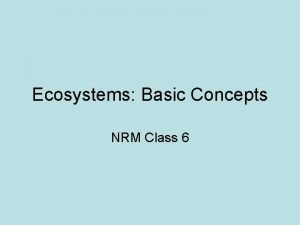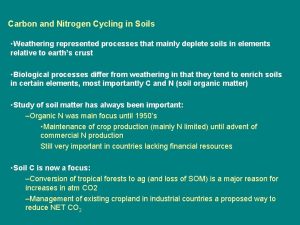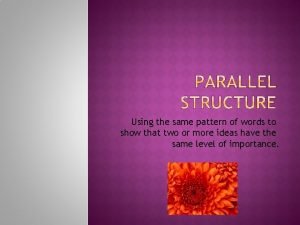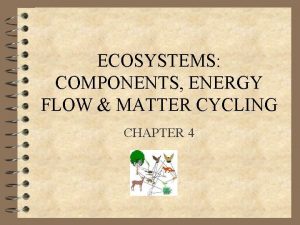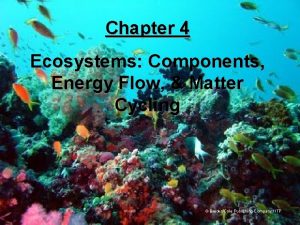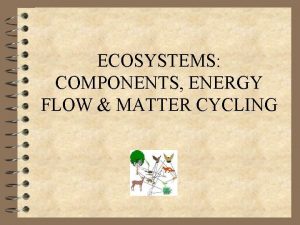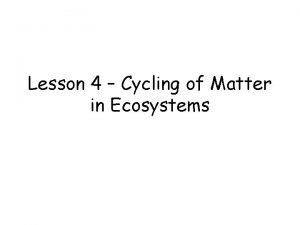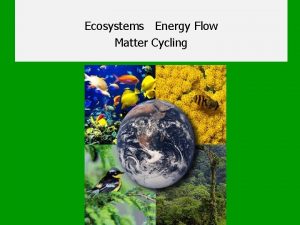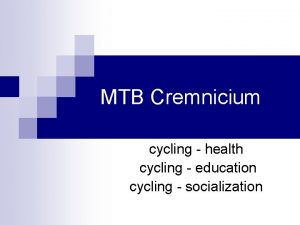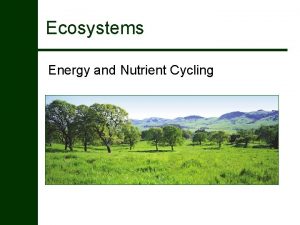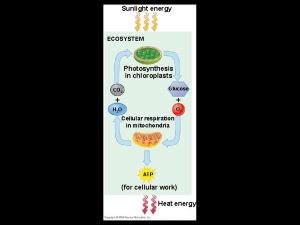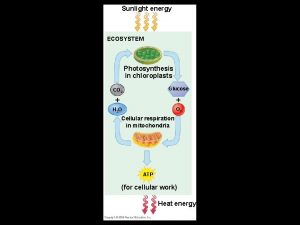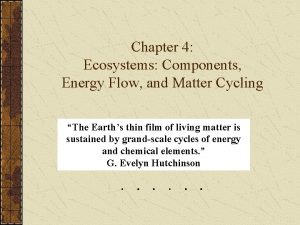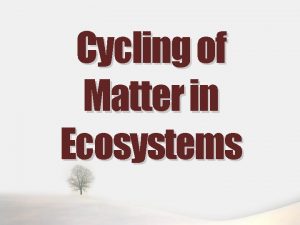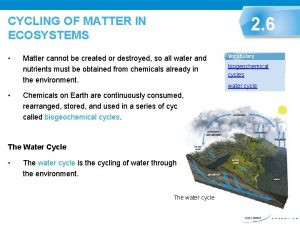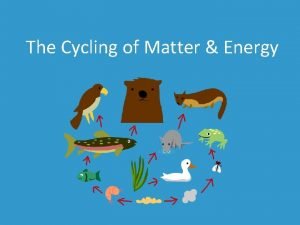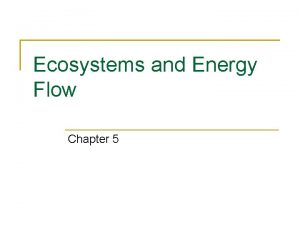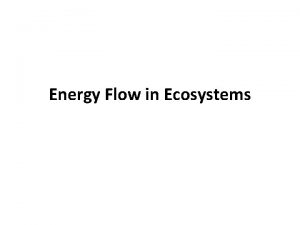Ecosystems Components Energy Flow and Matter Cycling G

























- Slides: 25

Ecosystems: Components, Energy Flow, and Matter Cycling G. Tyler Miller’s Living in the Environment 13 th Edition Chapter 4 Dr. Richard Clements Chattanooga State Technical Community College

Key Concepts Ø Basic ecological principles Ø Major components of ecosystems Ø Matter cycles and energy flow Ø Ecosystem studies Ø Ecological services

The Nature of Ecology Ø Ecosystem organization Ø Organisms Ø Populations Ø Communities Ø Ecosystems Ø Biosphere Fig. 4 -2 p. 66

The Earth’s Life-Support Systems Ø Troposphere Ø Stratosphere Ø Hydrosphere Ø Lithosphere Ø Biosphere Fig. 4 -6 p. 68

Sustaining Life of Earth Ø One-way flow of energy Ø Cycling of matter Fig. 4 -7 p. 69

The Source of Energy Fig. 4 -8 p. 69

Ecosystem Concepts and Components Ø Biomes Ø Role of climate Ø Aquatic life zones Fig. 4 -9 p. 70

Ecosystem Boundaries: Ecotones Fig. 4 -10 p. 71

Principles of Ecological Factors Ø Abiotic factors Ø Law of tolerance Ø Limiting factors Ø Biotic factors Fig. 4 -14 p. 73; Refer to Fig. 4 -13 p. 73

The Biotic Components of Ecosystems Ø Producers (autotrophs) Ø Photosynthesis Ø Consumers (heterotrophs) Ø Aerobic respiration Ø Decomposers Fig. 4 -16 p. 75

Trophic Levels Ø Primary consumer (herbivore) Ø Secondary consumer (carnivore) Ø Tertiary consumer Ø Omnivore Ø Detritivores and scavengers Ø Decomposers

Biodiversity Ø Genetic diversity Ø Species diversity Ø Ecological diversity Ø Functional diversity

Connections: Food Webs and Energy Flow in Ecosystems Ø Food chains Ø Food webs Fig. 4 -18 p. 77; Refer to Fig. 4 -19 p. 78

Ecological Pyramids Ø Pyramid of energy flow Ø Ecological efficiency Ø Pyramid of biomass Ø Pyramid of numbers Fig. 4 -20 p. 79

Primary Productivity of Ecosystems Ø Gross primary productivity (GPP) Ø Net primary productivity (NPP) Fig. 4 -25 p. 81

Connections: Matter Cycling in Ecosystems Ø Biogeochemical cycles Ø Hydrologic cycle (H 2 O) Ø Atmospheric cycles (C, N) Ø Sedimentary cycles (P, S)

Hydrologic (Water) Cycle Fig. 4 -27 p. 83

The Carbon Cycle (Terrestrial) Fig. 4 -28 p. 84 -85

The Carbon Cycle (Aquatic) Fig. 4 -28 p. 84 -85

The Nitrogen Cycle Fig. 4 -29 p. 86

The Phosphorus Cycle Fig. 4 -30 p. 88

The Sulfur Cycle Fig. 4 -31 p. 89

How Do Ecologists Learn About Ecosystems? Ø Field research Ø Remote sensing Ø Geographic information systems (GIS) Ø Laboratory research Ø Systems analysis

GIS and Systems Analysis Fig. 4 -32 p. 91 Fig. 4 -33 p. 91

Ecosystem Services and Sustainability Fig. 4 -34 p. 92
 Matter cycling in ecosystems
Matter cycling in ecosystems Energy flow and material cycling in ecosystem
Energy flow and material cycling in ecosystem Energy flow and material cycling in ecosystem
Energy flow and material cycling in ecosystem Phosphorus cycle
Phosphorus cycle Flow of energy vs flow of matter
Flow of energy vs flow of matter Oikos meaning
Oikos meaning Energy flow and chemical recycling in ecosystems
Energy flow and chemical recycling in ecosystems Chapter 4 lesson 2 energy flow in ecosystems answer key
Chapter 4 lesson 2 energy flow in ecosystems answer key Energy in ecosystems lesson 3 answer key
Energy in ecosystems lesson 3 answer key Primary consumer definition
Primary consumer definition Section 1 energy flow in ecosystems
Section 1 energy flow in ecosystems Precipitation in the water cycle
Precipitation in the water cycle Section 3 cycling of matter answer key
Section 3 cycling of matter answer key Principles of ecology section 3 cycling of matter
Principles of ecology section 3 cycling of matter Chapter 2 principles of ecology
Chapter 2 principles of ecology Principles of ecology section 2.1 worksheet answers
Principles of ecology section 2.1 worksheet answers Cycling of matter definition biology
Cycling of matter definition biology Chapter 42 ecosystems and energy
Chapter 42 ecosystems and energy Regents biology food chains and energy in ecosystems
Regents biology food chains and energy in ecosystems Lab food chains and energy in ecosystems
Lab food chains and energy in ecosystems Section 3 energy in ecosystems
Section 3 energy in ecosystems How does energy move through most ecosystems on earth
How does energy move through most ecosystems on earth Energy transfer in ecosystem
Energy transfer in ecosystem Ecosystem definition class 6
Ecosystem definition class 6 Carbon and nitrogen cycling in soil:
Carbon and nitrogen cycling in soil: Words with the same pattern
Words with the same pattern
